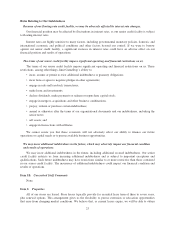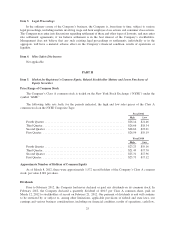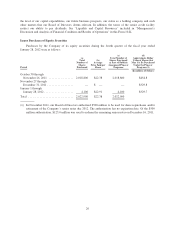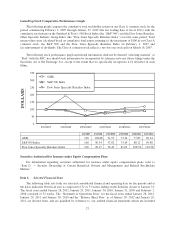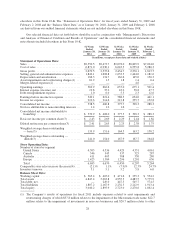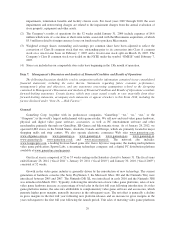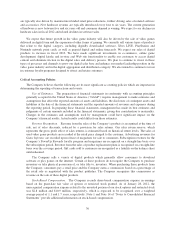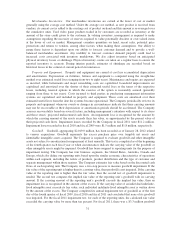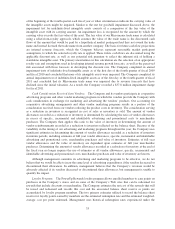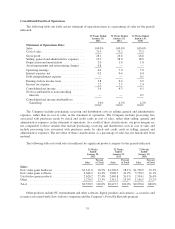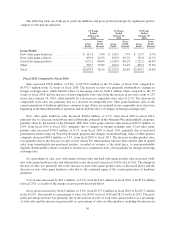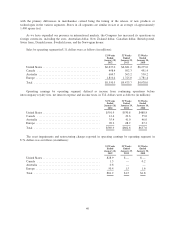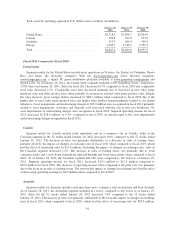GameStop 2011 Annual Report Download - page 49
Download and view the complete annual report
Please find page 49 of the 2011 GameStop annual report below. You can navigate through the pages in the report by either clicking on the pages listed below, or by using the keyword search tool below to find specific information within the annual report.of the beginning of the fourth quarter each fiscal year or when circumstances indicate the carrying value of
the intangible assets might be impaired. Similar to the test for goodwill impairment discussed above, the
impairment test for indefinite-lived intangible assets consists of a comparison of the fair value of the
intangible asset with its carrying amount. An impairment loss is recognized for the amount by which the
carrying value exceeds the fair value of the asset. The fair value of our Micromania trade name is calculated
using a relief-from-royalty approach, which assumes the value of the trade name is the discounted cash
flows of the amount that would be paid by a hypothetical market participant had they not owned the trade
name and instead licensed the trade name from another company. The basis for future cash flow projections
are internal revenue forecasts, which the Company believes represent reasonable market participant
assumptions, to which the selected royalty rate is applied. These future cash flows are discounted using the
applicable discount rate, as well as any potential risk premium to reflect the inherent risk of holding a
standalone intangible asset. The primary uncertainties in this calculation are the selection of an appropriate
royalty rate and assumptions used in developing internal revenue growth forecasts, as well as the perceived
risk associated with those forecasts in developing the discount rate. The Company completed its annual
impairment tests of indefinite-lived intangible assets as of the first day of the fourth quarter of fiscal 2009
and fiscal 2010 and concluded that none of its intangible assets were impaired. The Company completed its
annual impairment test of indefinite-lived intangible assets as of the first day of the fourth quarter of fiscal
2011 and concluded that its Micromania trade name was impaired due to revenue forecasts that have
declined since the initial valuation. As a result, the Company recorded a $37.8 million impairment charge
for fiscal 2011.
Cash Consideration Received from Vendors. The Company and its vendors participate in cooperative
advertising programs and other vendor marketing programs in which the vendors provide the Company with
cash consideration in exchange for marketing and advertising the vendors’ products. Our accounting for
cooperative advertising arrangements and other vendor marketing programs results in a portion of the
consideration received from our vendors reducing the product costs in inventory. The consideration serving
as a reduction in inventory is recognized in cost of sales as inventory is sold. The amount of vendor
allowances recorded as a reduction of inventory is determined by calculating the ratio of vendor allowances
in excess of specific, incremental and identifiable advertising and promotional costs to merchandise
purchases. The Company then applies this ratio to the value of inventory in determining the amount of
vendor reimbursements recorded as a reduction to inventory reflected on the balance sheet. Because of the
variability in the timing of our advertising and marketing programs throughout the year, the Company uses
significant estimates in determining the amount of vendor allowances recorded as a reduction of inventory
in interim periods, including estimates of full year vendor allowances, specific, incremental and identifiable
advertising and promotional costs, merchandise purchases and value of inventory. Estimates of full year
vendor allowances and the value of inventory are dependent upon estimates of full year merchandise
purchases. Determining the amount of vendor allowances recorded as a reduction of inventory at the end of
the fiscal year no longer requires the use of estimates as all vendor allowances, specific, incremental and
identifiable advertising and promotional costs, merchandise purchases and value of inventory are known.
Although management considers its advertising and marketing programs to be effective, we do not
believe that we would be able to incur the same level of advertising expenditures if the vendors decreased or
discontinued their allowances. In addition, management believes that the Company’s revenues would be
adversely affected if its vendors decreased or discontinued their allowances, but management is unable to
quantify the impact.
Loyalty Program. The PowerUp Rewards loyalty program allows enrolled members to earn points on
purchases in the Company’s stores and on some of the Company’s Web sites that can be redeemed for
rewards that include discounts or merchandise. The Company estimates the net cost of the rewards that will
be issued and redeemed and records this cost and the associated balance sheet reserve as points are
accumulated by loyalty program members. The two primary estimates utilized to record the balance sheet
reserve for loyalty points earned by members are the estimated redemption rate and the estimated weighted-
average cost per point redeemed. Management uses historical redemption rates experienced under the
33


